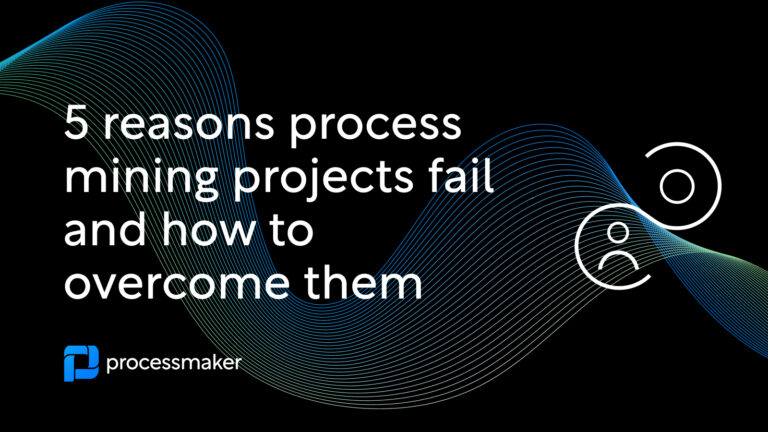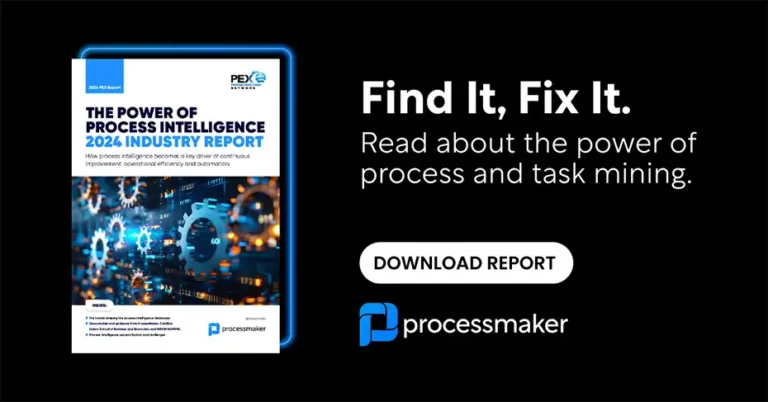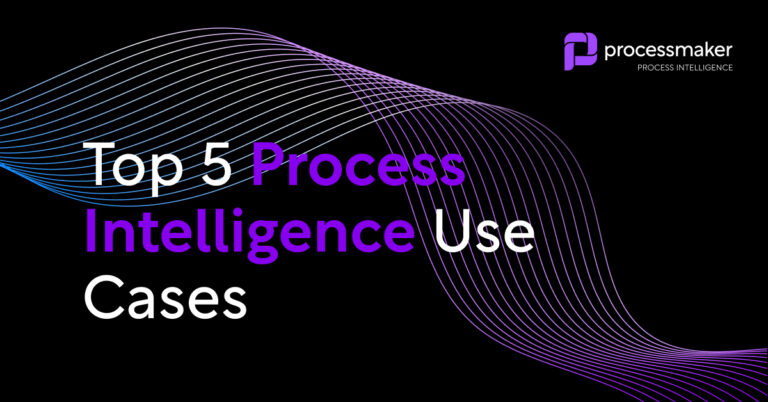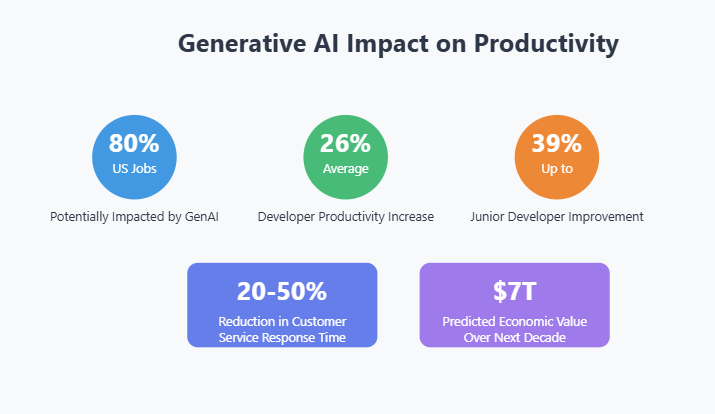Process mining has emerged as an essential tool for businesses looking to optimize their processes, improve efficiency, and reduce costs. By understanding and optimizing processes through data analysis and continuous monitoring, organizations can achieve better business outcomes. However, not every process mining project is a success story.
In this article, we will discuss the five common failures of process mining projects and how to overcome them. By understanding these challenges and implementing the suggested solutions, you can greatly improve the chances of success for your process mining initiatives.
What is process mining? Examples and Applications
Process mining is an advanced process mapping technique that uses knowledge extracted from event logs in enterprise IT systems to gain insight into how processes and workflows are executed in a business. Enterprise resource planning (ERP) systems contribute to this data by providing event log data extracted from information systems, which helps in understanding and optimizing operational processes. This helps organizations understand their current operational performance, identify inefficiencies, and find opportunities for improvement.
Process mining software combines data mining, process modeling, and process analysis to provide a comprehensive view of business processes. You can consider process mining as the application of data science to the art of business process management. Process mining uses process mining algorithms to analyze and reconstruct the actual process flow, enabling organizations to understand how their processes really function. It works by transforming data from ERP and CRM systems into event logs, which are then used to create visualizations and models of the business processes for performance analysis and improvement.
Process mining plays a crucial role in many competitive sectors of digital work as it helps organizations identify bottlenecks, inefficiencies, and compliance issues. By addressing these challenges, businesses can streamline their processes, cut costs, and improve overall performance.
The rising popularity of process mining in the enterprise
Process mining is the most widely adapted process intelligence software solution – and has become increasingly popular in enterprise businesses. According to recent research by Deloitte 63% of global companies have started using process mining, and most global businesses plan to at least pilot process mining in the near future.
The enthusiasm for process mining is largely justified. A major survey of enterprise decision-makers by HFS Research recently found that over 90% of respondents see process intelligence (a combination of process mining and process discovery) as hugely valuable in driving business value. Advanced process mining solutions are essential for continuous performance monitoring and compliance tracking.
Despite its potential benefits, many process mining projects fail due to a variety of reasons. The same study by HFS Research found that over 2 in 3 process intelligence solutions driven by process mining and discovery had led to disappointing results, or under-delivered on promise.
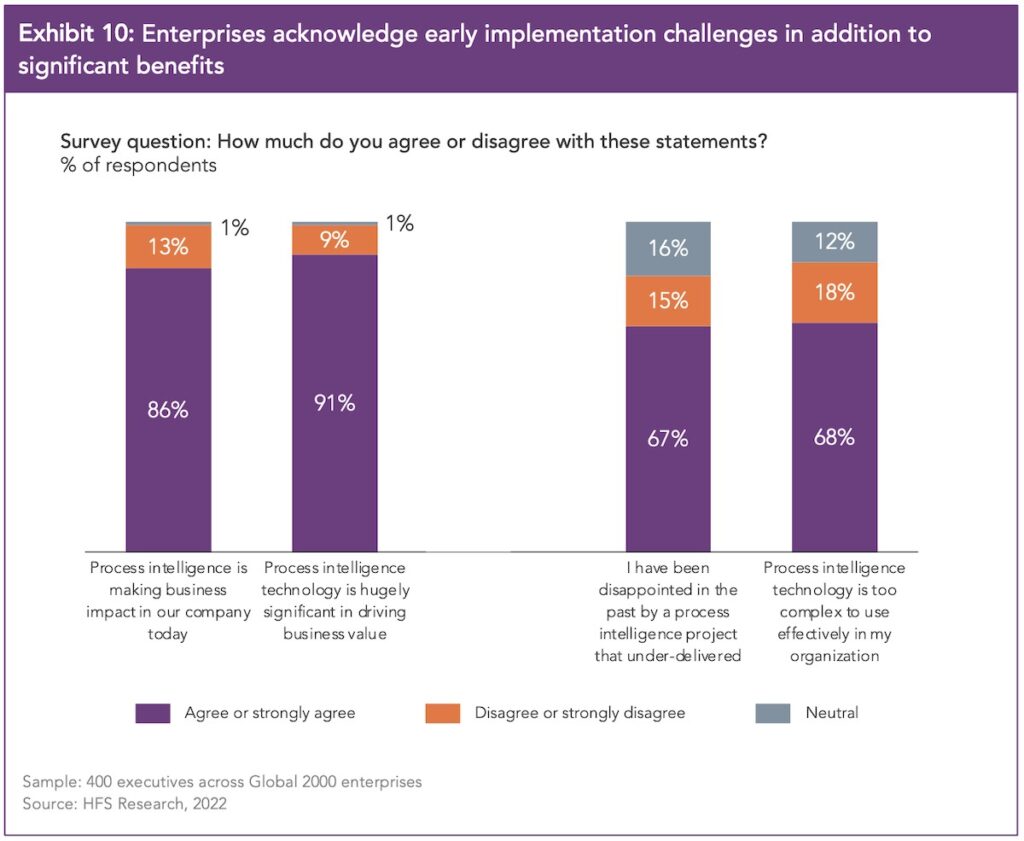
Source: Meteoric rise of process intelligence, HFS Research
Process Mining Pros and Cons: Advantages and Disadvantages
For an enterprise leader, process mining is often an advanced solution to a well-recognized business need. Most businesses utilize some form of process analysis to support operational excellence and business process management. These more traditional methods include process discovery workshops, process analysis audits, or time and motion studies conducted by either expert consultants or business process analysts. Process analytics plays a crucial role in evaluating and improving business processes by providing insights derived from data analysis, identifying optimal process paths, monitoring KPIs, and visualizing processes to recognize inefficiencies and facilitate continuous improvement.
Compared to manual process analysis, process mining offers many advantages and has a few disadvantages. Process mining can streamline process automation, improve business outcomes, and enable organizations to identify opportunities for automation, ultimately connecting with robotic process automation (RPA) to optimize overall performance.
Advantages of process mining
- Detailed process visibility: Process mining provides a clear and accurate visualization of the actual process flow, which helps organizations understand their processes better and identify areas for improvement. Process mining tools facilitate the visualization of business processes and identify inefficiencies, enabling organizations to prioritize optimization efforts.
- Automated bottleneck analysis: By analyzing event logs, process mining can pinpoint bottlenecks and inefficiencies in the process flow, enabling businesses to focus on areas that need improvement.
- Real-time performance measurement: Process mining offers quantitative metrics, such as cycle time, throughput, and resource utilization, to measure process performance. This helps organizations track progress and evaluate the effectiveness of process improvements.
- Compliance Monitoring: Process mining can detect deviations from standard procedures, ensuring compliance with internal policies and external regulations.
- Objective Decision-Making: Unlike process analysis based on surveys or expert opinions, process mining uses data-driven insights to support decision-making, reducing the reliance on subjective views and gut feelings.
Disadvantages of process mining
- Data quality and availability: Process mining relies heavily on accurate and complete data in enterprise source systems. If the data is of poor quality or is not available, the results of process mining can be misleading or incomplete.
- Integration complexity: Process mining can be complex, especially when dealing with large and intricate processes spanning more than one enterprise system. This may require advanced integration skills, which can be a barrier for some organizations. Additionally, managing complex processes presents significant challenges, but advanced techniques like object-centric or multi-level process mining can aid in navigating these complexities, boosting efficiency and insight extraction across various business processes.
- Cost of operation: Implementing process mining solutions can be expensive, particularly for small and medium-sized businesses. The costs may include software licenses, integration, maintenance, and consulting services.
- Scope of analysis: Process mining gives a detailed view of process data from enterprise systems like the ERP or CRM, but lacks the ability to monitor process and workflow activity across the broad range of business applications used today. For this limitation, many process mining solutions include functionality.
Common Failures in Process Mining Projects
According to famous research by McKinsey, 70% of transformation programs fail. Failure is not uncommon across intelligent automation software and in process mining. Process improvement is crucial in overcoming these challenges by enhancing operational efficiency and effectiveness.
Here are some common reasons for failures in process mining projects:
- Insufficient data quality
Poor data quality is one of the primary reasons process mining projects fail. Inaccurate or incomplete data can lead to misleading results, rendering the entire project ineffective. One of the common reasons why data quality is poor is because event log data is unavailable or unreliable across the enterprise systems used by the business. This is especially the case of any businesses not using SAP as their core ERP system.
- Lack of stakeholder buy-in
Process mining projects often involve significant organizational change requiring both business and IT leadership buy-in. If key stakeholders are not on board, the project may face resistance and ultimately fail. It may also be that process mining is championed by some aspects of operational leadership during a proof-of-concept, but to fully succeed it needs a buy-in to be effectively rolled out across the enterprise.
- Misaligned expectations and timelines
Many enterprise leaders have reported that process mining requires significant time and resources to be rolled out. It is not uncommon for a process mining implementation to take 12 to 24 months, and even longer in large organizations. Unrealistic expectations regarding the results of process mining projects can lead to disappointment and project failure.
- Poorly defined project scope
Many process mining initiatives start with a proof-of-concept in a clearly defined business use case, for example in analyzing P2P processes or even specific processes within procurement. While these “quick win” projects deliver immediate results, some enterprise leaders find it challenging to broaden the scope of analysis to other core workflows and functions. A lack of clear objectives and scope can result in an unfocused project that fails to deliver meaningful outcomes.
- Inadequate skillsets and resources
Process mining requires a combination of technical, analytical, and domain expertise. A lack of these necessary skills can lead to project failure and many larger enterprise organizations resort to hiring teams of data scientists within a dedicated center of excellence (CoE). Recent research by Deloitte found that the average process mining CoE consisted of 15 FTEs (full-time equivalents) with the largest CoE for process mining consisting of over 150 skilled employees.
How to Overcome Process Mining Project Failures
By addressing the common causes of failure, organizations can significantly increase the likelihood of success for their process mining projects. Additionally, leveraging process mining techniques can optimize processes, improve project outcomes, and provide real-time insights into operational efficiency.
Enhance data quality
Ensuring that your data is accurate, complete, and up-to-date is essential for a successful process mining project. Invest time and resources in data cleansing and validation, and establish a robust data governance framework.
Gain stakeholder support
Engage with stakeholders early in the project and maintain open communication throughout the process. Clearly articulate the benefits of process mining and demonstrate how it can address specific pain points within the organization. This will help to gain stakeholder buy-in and support for the project.
Align expectations and timelines
Set realistic expectations for your process mining project by clearly defining the scope, objectives, and desired outcomes. Communicate these expectations to all stakeholders and regularly review progress to ensure alignment.
Clarify project scope and goals
Develop a well-defined project scope that outlines the specific processes to be analyzed, the expected outcomes, and the required resources. This will help keep the project focused and on track, increasing the likelihood of success.
Develop necessary skillsets
Invest in building the necessary technical, analytical, and domain expertise within your team. Provide training and development opportunities to help your team acquire the skills needed for successful process mining projects.
Consider an alternative – hybrid process intelligence and process mining tools
If you’re concerned about the heavy commitment needed for successful process mining projects you may be interested to know there is an alternative.
Hybrid process intelligence is a new option developed by ProcessMaker combining process mining task mining. It is 10x faster to give process insights and up to 3x lower in total-cost-of-ownership than conventional process mining.
Hybrid process intelligence is particularly popular with knowledge-intensive digital work, for example, insurance claims, financial operations, and banking. Typically enterprise business customers uncover ~20% savings within 30 days of plug-and-play installation of ProcessMaker process intelligence (PI). For instance, a medium-sized accounting firm uncovered over € 2 million ($2.17 million) in process waste.
Conclusion
Process mining projects can deliver significant benefits to organizations when implemented correctly. By understanding and addressing the common causes of failure, businesses can greatly increase their chances of success in process mining initiatives. By enhancing data quality, gaining stakeholder support, aligning expectations, clarifying project scope, and developing the necessary skills, organizations can overcome the challenges that often lead to process mining project failures and unlock the full potential of this powerful technique.
FAQs:
What is process mining?
Process mining is a technique that analyzes business processes by extracting knowledge from event logs, which are recorded by IT systems during the execution of processes.
Why is process mining important?
Process mining helps organizations identify bottlenecks, inefficiencies, and compliance issues in their processes, allowing them to streamline operations, cut costs, and improve overall performance.
What are some common reasons for process mining project failures?
Insufficient data quality, lack of stakeholder buy-in, misaligned expectations, poorly defined project scope, and inadequate skillsets are common reasons for process mining project failures.
How can organizations overcome process mining project failures?
Organizations can overcome process mining project failures by enhancing data quality, gaining stakeholder support, aligning expectations, clarifying project scope, and developing the necessary skillsets.
What skill sets are required for successful process mining projects?
Successful process mining projects require a combination of technical, analytical, and domain expertise. Investing in training and development opportunities can help build these necessary skills within your team.
